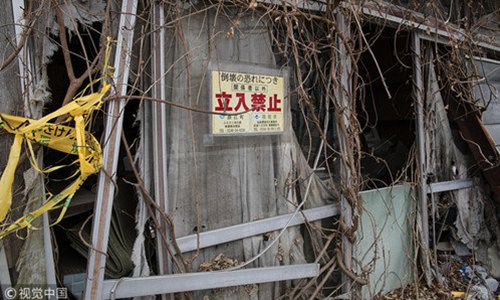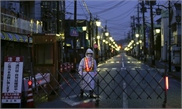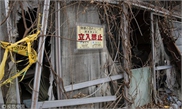
The 8th anniversary of the 2011 earthquake and tsunami in Japan. A photographer took pictures of the ruins of the hard-hit Namie in Fukushima, Northeast Japan. Vacant storefronts line the once prosperous streets. More than 20,000 people were killed by the disaster, and more than 50,000 people still remain displaced from their homes up to now. Photo: VCG
At the wrecked Fukushima nuclear plant north of Tokyo, workers in protective suits are still removing radioactive material from reactors that melted down after an earthquake and tsunami knocked out its power and cooling nearly nine years ago.On an exclusive tour of the plant, spread over 3.5 million square meters, Reuters witnessed giant remote-controlled cranes dismantling an exhaust tower and other structures in a highly radioactive zone while spent fuel was removed from a reactor.
Officials from Tokyo Electric Power Co. Holdings (Tepco), which owns the plant, also showed new tanks to hold increasing amounts of contaminated water.
About 4,000 workers are tackling the cleanup, many wearing protective gear, although more than 90 percent of the plant is deemed to have so little radioactivity that no extra precautions are needed. Photography was highly restricted and no conversations were allowed with the workers.
Work to dismantle the plant has taken nearly a decade so far, but with Tokyo due to host the Olympics this summer - including some events less than 60 kilometers from the power station - there has been renewed focus on safeguarding the venues.
The buildup of contaminated water has been a sticking point in the cleanup, which is likely to last for decades, and has alarmed neighboring countries. In 2018, Tepco said it had not been able to remove all dangerous material from the water and the site is running out of room for storage tanks.
Officials overseeing a panel of experts looking into the contaminated water issue said in December choices on disposal should be narrowed to two: Either dilute the water and dump it in the Pacific Ocean, or allow it to evaporate.
The Japanese government may decide within months, and either process would take years to complete, experts say.
"The Olympics are coming, so we have to prepare for that, and Tepco has to disclose all the information not only to local communities but also to foreign countries and especially to those people coming from abroad," said Joji Hara, a Tokyo-based spokesperson for the power company who accompanied Reuters during the visit.
Tepco has opened English-language Twitter and Facebook accounts, he said. It is also preparing to put out basic emergency information in Korean and Chinese, he added.
Athletes from at least one country, South Korea, are planning to bring their own radiation detectors and food.
Baseball and softball will be played in Fukushima City, about 60 kilometers from the destroyed nuclear plant.
The torch relay will begin at a sports facility called J-Village, an operations base for Fukushima Daiichi in the first few years of the disaster, then pass through areas near the damaged station on its way to Tokyo.
Reuters


